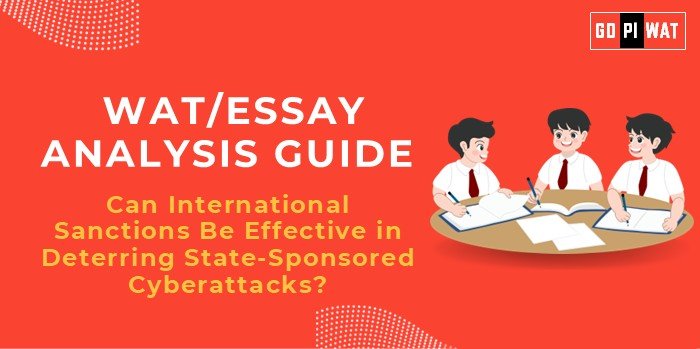📋 WAT/Essay Analysis Guide: The Role of Sanctions in Combating State-Sponsored Cyberattacks
🌟 Understanding the Topic’s Importance
Sanctions as deterrents connect economic, political, and technological themes, making them critical in global security discussions for B-school aspirants.
📝 Effective Planning and Writing
- ⏳ Time Allocation:
- Planning: 5 minutes
- Writing: 20 minutes
- Reviewing: 5 minutes
- 📋 Essay Structure:
- Introduction: Brief context and thesis (e.g., “Sanctions are both powerful and limited tools in combating state-sponsored cyberattacks.”).
- Body:
- Paragraph 1: Achievements (e.g., reduced cyber aggression).
- Paragraph 2: Challenges (e.g., circumvention issues).
- Paragraph 3: Recommendations (e.g., enhanced global cooperation).
- Conclusion: Future outlook.
🎯 Sample Essay Introductions
- ⚖️ Contrast Approach: “While sanctions deterred Russia’s overt cyber aggression in Europe, their inefficacy in halting covert operations raises questions about their future utility.”
- 💡 Solution-Oriented: “International sanctions remain a key deterrent against cyberattacks, but require advanced attribution technologies and global coalitions to succeed.”
🌱 Recommendations for Sustainable Progress
- 📊 Strengthen cyber attribution capabilities through AI and forensic technologies.
- 🌐 Foster multilateral frameworks for cohesive sanction enforcement.
- 🤝 Leverage public-private partnerships for better monitoring and compliance.
📄 Sample Short Essays
⚖️ Balanced Perspective
Sanctions against state-sponsored cyberattacks highlight a dual reality: while effective in signaling disapproval, their success hinges on global cooperation and technological advancements in attribution.
🔧 Solution-Oriented
To counter state-sponsored cyberattacks effectively, sanctions must evolve into a comprehensive tool supported by forensic technologies, global coalitions, and strategic diplomacy.
🌍 Global Comparison
Sanctions have shown mixed results globally, with successes like North Korea’s reduced ransomware operations contrasted by challenges in addressing China’s economic resilience.


